Conductive Polymer / Superconductor Sandwich Structures
- PDF / 400,457 Bytes
- 6 Pages / 414.72 x 648 pts Page_size
- 37 Downloads / 404 Views
STEVEN G. HAUPT, JIANAI ZHAO, RUNG-KUANG LO, JI-PING ZHOU AND JOHN T. McDEVIVF*, Department of Chemistry & Biochemistry, The University of Texas at Austin, Austin, TX 78712.
ABSTRACT Methods for characterizing the interface of conductive polymer/high-Tc superconductor sandwich structures are reported. Electrochemical procedures, such as cyclic voltammetry and chronoamperometry, are utilized to deposit conductive polymers directly onto bulk ceramic and thin film samples of YBa2Cu3O7-8. Moreover, similar methods are utilized to cycle the polymer structures between their neutral (non-conductive) and oxidized (conductive) forms. Through changes in the polymer doping level, the superconducting properties of the high-Tc component can be modulated in a controllable and reproducible fashion. This paper focuses on an analysis of conductive polymer/superconductor interface phenomena as explored by electrochemical, resistivity vs. temperature and contact resistance measurements. INTRODUCTION A number of research groups, including our own, have initiated studies designed to explore the synthesis and characterization of conductive polymer/high-Tc composite structures. 1 ,2,3 Conductive polymers possess many unique properties that complement the properties of high-Tc superconductors and make them possible candidates for application in composites, devices and circuits. We have found that high-temperature superconductors and conductive polymers can be used to form sandwich structures in which the conductive polymers can be used for controlling the electrical properties of an underlying superconductor thin film.1 When the conductive polymer is in its doped state, the superconducting transition temperature can be reduced to values that are as much as 50 K less than that found for the bare superconductor film. Following the room temperature reduction of the polymer to its non-conducting state, the transition temperature returns to a value very close to that of the bare superconductor film. Because the polymer can be reversibly charged and discharged, the hybrid structure forms the basis for a new type of molecular switch for controlling superconductivity. In order to form well-behaved junctions between high-Tc superconductors and conductive polymers, it is necessary to avoid chemical damage of both the superconductor and the conductive polymer materials. Unfortunately, both the cuprate compounds as well as the conductive polymer systems tend to degrade chemically upon exposure to the atmosphere. It is this environmental reactivity that make fabrication of the hybrid junctions challenging. This paper focuses on the preparation of conductive polymer/superconductor interfaces as well as on an analysis of their interfacial reactivity characteristics.
671 Mat. Res. Soc. Symp. Proc. Vol. 318. ©1994 Materials Research Society
Superconductor Limitations In order to prepare useful polymer/superconductor structures, it is necessary to utilize high-Tc thin films. Of the various available cuprate phases, only YBa2Cu3O7-8 can be prepared easi
Data Loading...











